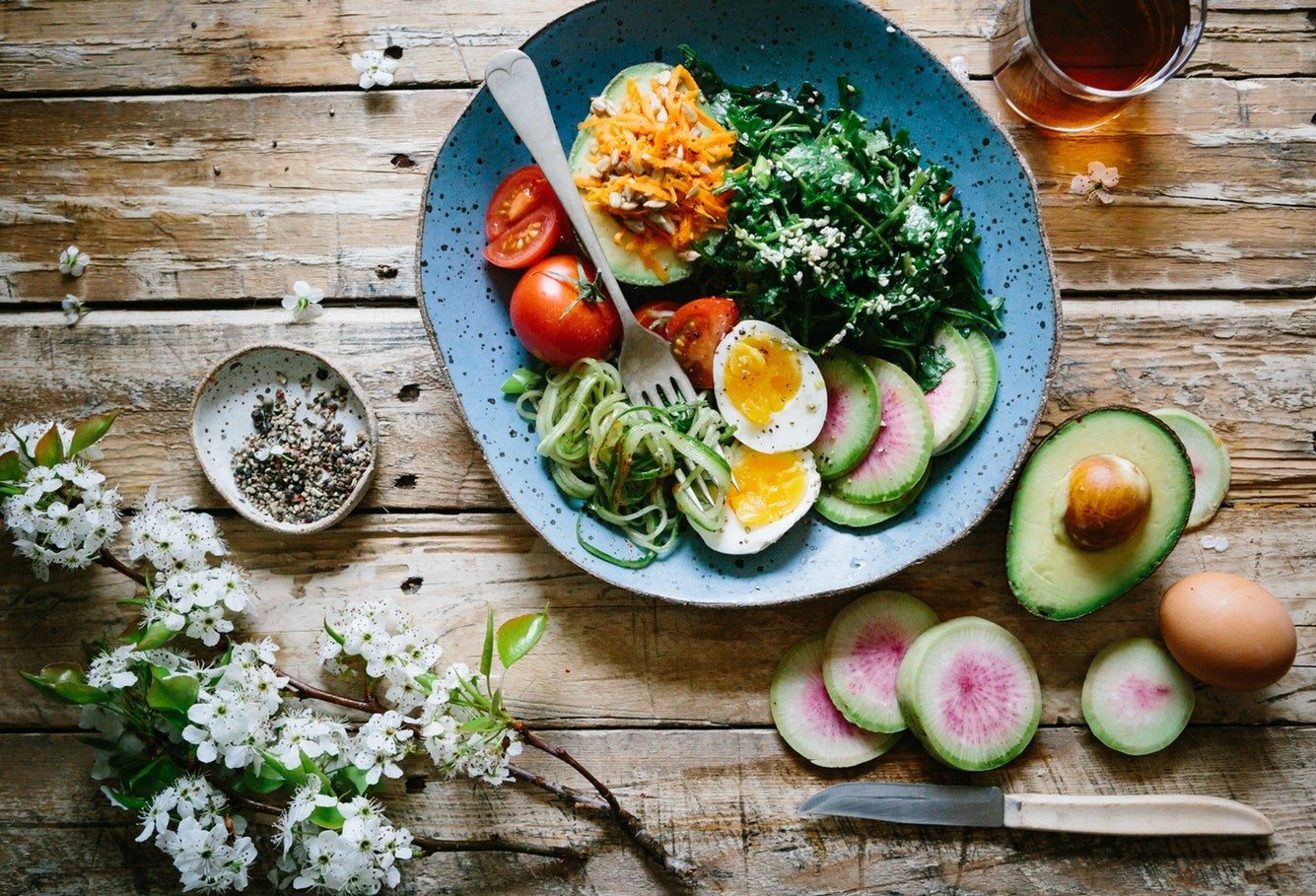Photo by Annie Spratt
Eggs were always part of Easter celebrations, representing the renewal of life and nature in the spring 1 and in Christian traditions the red-stained eggs represented the blood of Christ.2 But it wasn’t until the early 1900’s that chocolate eggs came into production in Europe – with France and Germany taking the lead in this new artistic confectionery. And while I’m not one to avoid a sweet treat like chocolate every now and again, I advise everyone against the cheap imitations that are a far cry from the original cacao bean and try to get good quality organic dark ones – better yet, make their own treats from raw ingredients, full of health giving goodness.
The health benefits of chocolate
The number of health benefits now associated with the cocoa bean are really quite impressive, including benefits to your heart and blood vessels, brain and nervous system, improved insulin sensitivity – protecting against pre-eclampsia in pregnancy, reducing inflammation and even possibly slowing down the rate at which we age.3 Proposed mechanisms underlying these benefits include enhanced nitric oxide bioavailability and improved mitochondrial structure/function.4 Data from numerous studies suggest that cocoa and cocoa-derived flavanols can effectively modify the inflammatory process, and thus potentially provide a benefit to individuals with elevated risk factors for chronic inflammatory pathology and cancer. 6,7
Cacao’s benefits are related to antioxidant compounds naturally occurring in the bean, including epicatechin and resveratrol, both powerful antioxidants also found in green tea and red wine.13 Epicatechin is thought to help shield your nerve cells from damage. The Kuna people of Panama consume up to 40 cups of cocoa and have less than a 10 percent risk of stroke, heart failure, cancer and diabetes, which are the most prevalent diseases ravaging the Western world.8 Cocoa beans have been also proved to improve endurance, improve liver function, lower the risk of Alzheimer’s disease and so on.3
According to a systematic review,5 the evidence is strong for an association with increased flow-mediated vasodilatation(FMD) and moderate for an improvement in blood glucose and lipid metabolism. The analysis showed that cocoa products with around 100 mg epicatechin can reliably increase FMD, and that cocoa flavanol doses of around 900 mg or above may decrease blood pressure in specific individuals and/or if consumed over longer periods.
Yes indeed, there are numerous studies available on the health-giving properties of high quality chocolate, especially when it comes to our fast-paced, stressful Western lifestyle. It improves mood, cognitive function 9,10 and helpful in dealing with stress. A recent study published in the Journal of American College of Cardiology 11 confirmed that high quality dark chocolate intake buffers stress reactivity, thereby helping to protect the body from the damages associated with acute stress in healthy individuals. The dark chocolate used was 72% cacao and contained 125 mg of epicatechin per 50-g serving. Although this study was funded by Swiss Cocoa and Chocolate Foundation grant…
Choose chocolate wisely
When selecting chocolate, you can optimize its nutritional punch by looking for raw products, higher cacao and lower sugar content – ideally sweetened with raw honey. In general, the darker the chocolate, the higher the cacao content. However, cacao is fairly bitter, and the higher the percentage cacao, the more bitter it is. The flavanols are what make the chocolate bitter, so manufacturers often remove them. But, it’s those flavanols that are responsible for many of chocolate’s health benefits.13
The closer the chocolate is to its natural raw state, the higher its nutritional value. Ideally, your chocolate or cocoa should be consumed raw (as cacao nibs, powder and bars). Commercial chocolates and cocoa powder is raw cacao that has been roasted at high temperatures and treated with chemicals. Sadly, roasting changes the molecular structure of the cocoa bean, reducing the enzyme content and lowering the overall nutritional value.12 Added sugars, milk solids, damaged fats and chemicals cancel out all its benefits.
Check what type of fat your chocolate bar contains. Naturally occurring fat in chocolate called cacao butter is good for you. It slows down the absorption of sugar, reducing the dangerous insulin spike.14 The primary fatty acid in cocoa butter is stearic acid, which is the only saturated fat that favourably affects HDL, without adversely affecting LDL.15 Processed cheap chocolates often have this butter removed and replaced by vegetable oils or dairy fats.
Look also for the type of sweetener used. Not only should you choose chocolate with low sugar content, but you should also look at what form of sugar it contains. Honey is sometimes used to sweeten raw chocolate products, which is a good choice (in moderation). If you can find chocolate sweetened with stevia or xylitol that would be preferable to cane sugar, fructose or high fructose corn syrup. Strictly avoid any product containing artificial sweeteners.
Avoid also genetically modified (GM) cocoa beans. GM foods represent the newest addition to our diet and wreaking havoc ever since. In addition to promoting dangerous horizontal transfer of antibiotic resistant genes, their consumption decreases DNA methylation allowing cancerous genes to run wild.16 Chose certified organic products, so that you can be sure they aren’t GM. Most chocolate today (even dark chocolate) is GM, unfortunately.
How much should we eat?
In order to fully benefit from chocolate, you’d have to consume around 100 mg epicatechin can reliably increase flow mediated vasodilation, and that cocoa flavanol doses of around 900 mg or above may decrease blood pressure in specific individuals and/or if consumed over longer periods. To achieve these doses with chocolate, around 100 to 500 g (for 900 mg flavanols) and 50 to 200 g (for 100 mg epicatechin) would need to be consumed – depending on the product.5 Raw dark chocolates have >80 more antioxidants than processed ones,12 therefore much less is enough, with that sugar consumption can be kept at the minimum. In general, it seems preferable to consume smaller amounts of chocolate at more frequent intervals, much like the principle of split dosing for supplements, in order to ensure a steadier stream of nutrients in your bloodstream.
For best results, get raw cacao powder from your local health food stores instead of sweetened chocolate products, and add a good tablespoon of it to your porridge, protein smoothies and home-made energy balls. Raw cacao nibs are also available, these are fantastic in granola or muesli in the morning, or mixed with nuts, toasted coconut flakes and Goji berries – they make a fantastic snack.
Here’s how to make your own healthy chocolate eggs:
Raw Chocolate Easter Eggs
Ingredients
- 50 g (1/3 cup melted) cacao butter.
- 25 g (2 tablespoons) coconut oil.
- 60 g (1 loose cup) raw cacao powder.
- 1 tbsp raw honey
- ¼ cup Meridian cocoa-hazelnut spread for the filling.
You will need an egg-mould. In a medium sized bowl, heat the cacao butter and coconut oil over a pot of hot water until completely melted together. Remove from heat and stir through the honey and the cacao powder ensuring there are no lumps. Continue to stir for a couple of minutes to cool.
Spoon approximately one teaspoon of the melted chocolate into each mould. Gently swirl around until all sides are evenly coated.
Place your moulds in the freezer to set.
Fill the chocolate shells with the cocoa-hazelnut spread and melting the edges with a hot spoon press the halves gently together and place in the fridge to set.
References:
1, Leeming, D. (2005). The Oxford Companion to World Mythology. Oxford University Press.
2, Thompson, K. (21 August 2013). Culture & Progress: Early Sociology of Culture, Volume 8. Routledge. p. 138.
3, van Wensem J. 2015. Overview of scientific evidence for chocolate health benefits. Integr Environ Assess Manag.;11(1):176-7. doi: 10.1002/ieam.1594
4, Higginbotham E. and Taub PR. 2015. Cardiovascular Benefits of Dark Chocolate? Curr Treat Options Cardiovasc Med.;17(12):54. doi: 10.1007/s11936-015-0419-5
5, Vlachojannis J, et al. 2016. The Impact of Cocoa Flavanols on Cardiovascular Health. Phytother Res.; 30(10):1641-1657.
6, Goya L. et al. 2016. Effect of Cocoa and Its Flavonoids on Biomarkers of Inflammation: Studies of Cell Culture, Animals and Humans. Nutrients.; 8(4):212. doi:10.3390/nu8040212
7, Zeng H. et al. 2011. Anti-inflammatory properties of clovamide and Theobroma cacao phenolic extracts in human monocytes: evaluation of respiratory burst, cytokine release, NF-κB activation, and PPARγ modulation. J Agric Food Chem.;59(10):5342-50. doi: 10.1021/jf2005386.
8, Hollenberg NK, Fisher ND and McCullough ML. 2009. Flavanols, the Kuna, cocoa consumption, and nitric oxide. J Am Soc Hypertens.; 3(2):105-12. doi: 10.1016/j.jash.2008.11.001.
9, Scholey A. and Owen L. 2013. Effects of chocolate on cognitive function and mood: a systematic review. Nutr Rev.;71(10):665-81. doi: 10.1111/nure.12065.
10, Mastroiacovo D, et al. 2015. Cocoa flavanol consumption improves cognitive function, blood pressure control, and metabolic profile in elderly subjects: the Cocoa, Cognition, and Aging (CoCoA) Study–a randomized controlled trial. Am J Clin Nutr.;101(3):538-48. doi: 10.3945/ajcn.114.092189.
11, Wirtz, PH. et al. 2014. Dark Chocolate Intake Buffers Stress Reactivity in Humans. Journal of the American College of Cardiology ; 63 (21) – S. 2297-2299
12, Payne MJ et al. 2010. Impact of fermentation, drying, roasting, and Dutch processing on epicatechin and catechin content of cacao beans and cocoa ingredients. J Agric Food Chem.;58(19):10518-27. doi: 10.1021/jf102391q.
13, Crozier SJ et al. 2011. Cacao seeds are a “Super Fruit”: A comparative analysis of various fruit powders and products. Chem Cent J.;5:5. doi: 10.1186/1752-153X-5-5.
14, Marsh CE, Green DJ, Naylor LH. and Guelfi KJ. 2017. Consumption of dark chocolate attenuates subsequent food intake compared with milk and white chocolate in postmenopausal women. Appetite; 116:544-551. doi: 10.1016/j.appet.2017.05.050.
15, Hunter JE, Zhang J. and Kris-Etherton PM. 2010. Cardiovascular disease risk of dietary stearic acid compared with trans, other saturated, and unsaturated fatty acids: a systematic review. Am J Clin Nutr.; 91(1):46-63. doi: 10.3945/ajcn.2009.27661
16, Kleter, G.A., Peijnenburg, A.C.M. and Aarts, H.J.M. 2005. Health Considerations Regarding Horizontal Transfer of Microbial Transfergenes Present in Genetically Modified Crops. Journal of Biomedicine and Biotechnology; 4:326-52. doi: 10.1155/jbb.2005.326.



